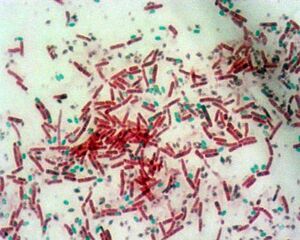Alicyclobacillus acidoterrestris: Difference between revisions
No edit summary |
No edit summary |
||
| Line 32: | Line 32: | ||
A. ''acidoterrestris'' is a non-pathogenic bacteria and is a major contaminant in the fruit juice industry. Due to its thermophilic nature, its endospores are able to survive the pasteurization process commonly used to kill bacteria and this can lead to spoilage across a large range of fruit juices and products. At higher pH conditions, the bacteria is more motile, but at lower pH conditions it tends to form biofilms. The ability to form biofilms coupled with its habitable temperature and pH ranges makes destroying this bacteria during processing very difficult. The bacteria itself does not lead to any disease in humans, but the guaiacol and phenols that it produces can lead to off-tasting fruit products and spoiled juice can be colonized by other bacteria which can be harmful to humans. | A. ''acidoterrestris'' is a non-pathogenic bacteria and is a major contaminant in the fruit juice industry. Due to its thermophilic nature, its endospores are able to survive the pasteurization process commonly used to kill bacteria and this can lead to spoilage across a large range of fruit juices and products. At higher pH conditions, the bacteria is more motile, but at lower pH conditions it tends to form biofilms. The ability to form biofilms coupled with its habitable temperature and pH ranges makes destroying this bacteria during processing very difficult. The bacteria itself does not lead to any disease in humans, but the guaiacol and phenols that it produces can lead to off-tasting fruit products and spoiled juice can be colonized by other bacteria which can be harmful to humans. | ||
[[File:endosporestain.jpg|none|thumb|Stained | [[File:endosporestain.jpg|none|thumb|Stained endospores]] | ||
Revision as of 15:31, 19 April 2022
Classification
Bacteria; Bacillota; Bacilli; Bacillales; Alicyclobacillaceae; Alicyclobacillus; A. acidoterrestris
Species
Description and Significance
A. acidoterrestris is an aerobic, gram positive, thermoacidophilic bacilli that produces endospores. It can survive in acidic environments down to 2.5 pH and grows at temperatures between 26°C and 55°C. The significance of this bacteria lies in its ability to contaminate juice products and survive the pasteurization process used to remove bacteria due to the heartiness of its endospores. This bacteria is found growing in soils, fruit juices, and orchards.
Genome Structure
The genome is 4,063,548 base pairs, singular, and circular. It has a Guanine -Cytosine content of 52.2% and contains about 4,145 protein coding genes. The genome contains a sporulation transcription activator that shares a 61% similarity with the Spo0A found in Bacillus subtilis and sporulation Kinase A (KinA) was also preserved in this genome.
- Fw Sequence: 5’-AGAGTTTGATCCTGGCTCA-3’, positions 8 to 26
- Rw Sequence: 5’-CGGCTACCTTGTTACGGAC-3’, positions 1511 to 1493
Cell Structure, Metabolism, and Life Cycle
A. acidoterrestris falls into the class bacillus, making it rod shaped. It is a prokaryotic cell lacking membrane bound organelles. Its life cycle consists of three processes, vegetative growth, sporulation, then germination. It is strictly aerobic, acidophilic, and thermophilic. A. acidoterrestris survives by metabolizing vitamin K, methylglyoxal, adipate, and propanol. It produces bromophenol and guaiacol, which are responsible for a spoiled taste in juice that A. acidoterrestris colonizes.
Ecology and Pathogenesis
A. acidoterrestris is a non-pathogenic bacteria and is a major contaminant in the fruit juice industry. Due to its thermophilic nature, its endospores are able to survive the pasteurization process commonly used to kill bacteria and this can lead to spoilage across a large range of fruit juices and products. At higher pH conditions, the bacteria is more motile, but at lower pH conditions it tends to form biofilms. The ability to form biofilms coupled with its habitable temperature and pH ranges makes destroying this bacteria during processing very difficult. The bacteria itself does not lead to any disease in humans, but the guaiacol and phenols that it produces can lead to off-tasting fruit products and spoiled juice can be colonized by other bacteria which can be harmful to humans.
References
Bevilacqua A, Mischitelli M, Pietropaolo V, Ciuffreda E, Sinigaglia M, Corbo MR. Genotypic and Phenotypic Heterogeneity in Alicyclobacillus acidoterrestris: A Contribution to Species Characterization. PLoS One. 2015;10(10):e0141228. Published 2015 Oct 20. doi:10.1371/journal.pone.0141228
Kinouchi T, Komeda T, Nakanishi K, Fujita Y, Deuchi K. Growth of Alicyclobacillus acidoterrestris in the Hypoxic Environment of Bottled Fruit Juice. Biocontrol Sci. 2014;19(2):85-8. doi: 10.4265/bio.19.85. PMID: 24975412.
Lorenz Christian Reimer, Joaquim Sardà Carbasse, Julia Koblitz, Christian Ebeling, Adam Podstawka, Jörg Overmann, BacDive in 2022: the knowledge base for standardized bacterial and archaeal data, Nucleic Acids Research, Volume 50, Issue D1, 7 January 2022, Pages D741–D746, https://doi.org/10.1093/nar/gkab961
Shemesh M, Pasvolsky R, Sela N, Green SJ, Zakin V. 2013. Draft genome sequence of Alicyclobacillus acidoterrestris strain ATCC 49025. Genome Announc. 1(5):e00638-13. doi:10.1128/genomeA.00638-13.
Walker, M. and Phillips, C.A. (2008), Alicyclobacillus acidoterrestris: an increasing threat to the fruit juice industry?. International Journal of Food Science & Technology, 43: 250-260. https://doi.org/10.1111/j.1365-2621.2006.01427.x
Author
Page authored by Alex Lam, Kyle Kristoff, students of Prof. Jay Lennon at Indiana University.



